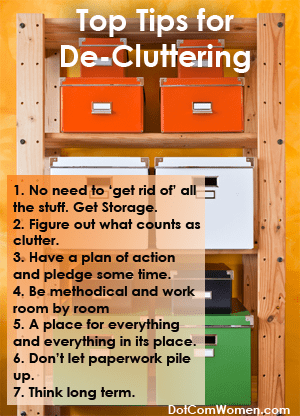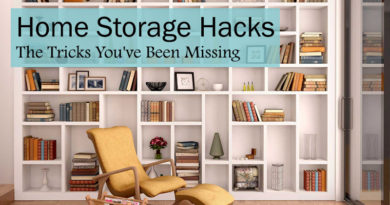Top Tips for De-cluttering
Clutter can make you feel overwhelmed, disorganised, and have a negative impact on your physical and mental health. It can even make you more likely to eat unhealthily!
If you are fed up of disorder and feel trapped or hemmed in by the sheer amount of stuff you have, now is the time to take action.
 Think outside the box–A clear out isn’t necessarily about getting rid of stuff. There may be things you want to hang on to for sentimental reasons. Or there might be items that aren’t useful at the moment but almost certainly will be in the future, for example baby clothes and toys. If you don’t have space for this stuff at home, you could consider putting it into storage where it will be safe, secure, and most importantly, out of your way. Companies like Ready Steady Store offer a range of options for people looking for short and longer-term storage.
Think outside the box–A clear out isn’t necessarily about getting rid of stuff. There may be things you want to hang on to for sentimental reasons. Or there might be items that aren’t useful at the moment but almost certainly will be in the future, for example baby clothes and toys. If you don’t have space for this stuff at home, you could consider putting it into storage where it will be safe, secure, and most importantly, out of your way. Companies like Ready Steady Store offer a range of options for people looking for short and longer-term storage.
Figure out what counts as clutter – Only you can decide what is rubbish and needs getting rid of, and what is precious and needs to be kept. One man’s rubbish is another man’s treasure after all.
Have a plan of action–Being clear on how you’re going to tackle your de-clutter project is essential. If you have a chunk of time you can dedicate to it you can make real progress in a few days. However, if you’re fitting a de-clutter around work and a family, you might want to pledge to do 15 minutes a day, every day. 15 minutes is long enough to make progress, but short enough to be achievable. When it comes to getting rid of junk and organising your living or work space, every little really does count.
Be methodical – You should work room by room to ensure the mess of sorting out is limited to one area at a time. This way, you’ll also appreciate the progress you’re making, especially if you’re taking the 15 minutes a day approach.
A place for everything and everything in its place – A key part of your de-cluttering process should be organising the stuff you do want to hold on to.If there are items that are of sentimental value, perhaps cards, letters, ticket stubs or photos, then you should keep them. But, make sure items like this have a set place to go. A memories box makes hanging on to treasured items hassle-free and neat and tidy.
Don’t let paperwork pile up – Is there anything more depressing than a big pile of paperwork and envelopes? With its bacteria like ability to multiply, paperwork is best tackled as soon as it comes in whether you’re at home or at work. Set up a filing cabinet so you can sort bills and letters easily and straight away. Deal with documents that require your input as soon as possible to avoid losing things or missing deadlines.
Think long term – The initial step of tackling your clutter is key. But you also need to think about how you will stay on top of things as time progresses. Without a little bit of ongoing effort, stuff will just build up again. A ‘little and often’ approach can work well, and you could also learn to build de-cluttering into regular tasks that you already do. You might want to have a mini de-clutter every time you dust, or when you add new clothes to the wardrobe think about taking something you no longer wear to a charity shop.
This article was written by Amanda Walters, an experienced freelance writer and regular contributor to Huffington Post. Follow her here: @Amanda_W84

